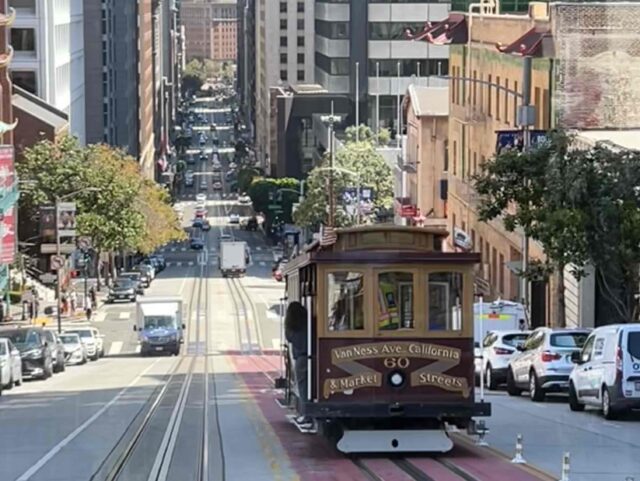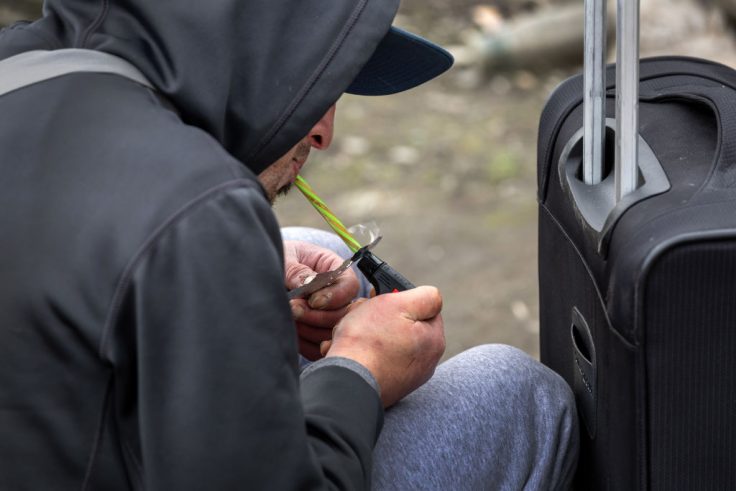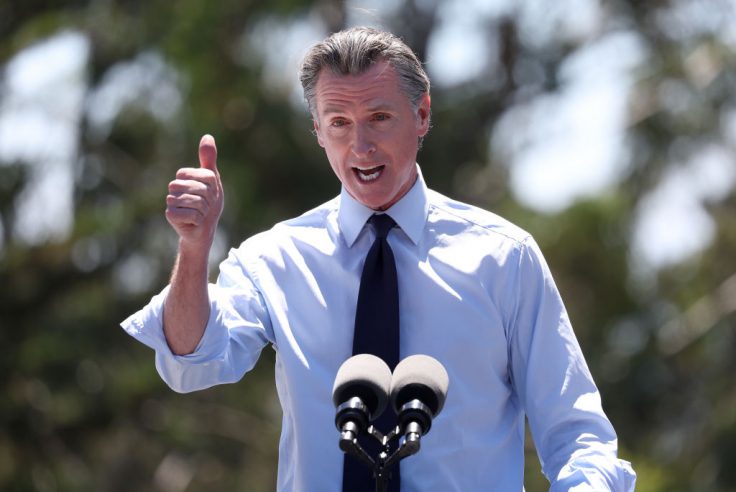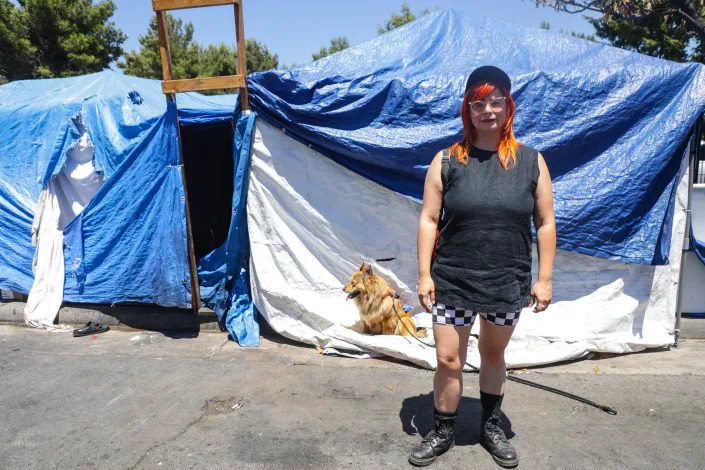SAN FRANCISCO IS WHERE THE TROIKA OF CORRUPTION FEINSTEIN, PELOSI, AND KAMALA HARRIS STARTED THEIR CORRUPT POLITICAL LIVES. DITTO GAVIN NEWSOM! YOU REALLY WANT THESE PEOPLE AROUND YOUR CITY???
San Francisco's Shopping Street Is Completely Empty | Literally No Stores Left
Newsom–DeSantis debate: Will it happen and who stands to benefit?
During a Hannity segment last week, Ron DeSantis agreed to a televised debate with Gavin Newsom:
“Absolutely I’m game. Just tell me when and where.”
The belligerent Newsom has been desperately trying to distract the country from California’s utter collapse by challenging Ron DeSantis to a debate. Florida governor, however, was not willing to elevate Newsom to the national conversation -- until now.
Both governors stand to gain from the hyped-up exhibition. Governor DeSantis is having a hard time articulating his conservative message to the national audience, as his main opponent, Donald Trump, continues to suck all the air out of the political discourse. Being hit by constant smears from the media and childish barrage of insults from Trump, Governor DeSantis needs a big platform to accurately define his message for the independent voters. Newsom is busy preparing for a Presidential campaign of his own, as Joe Biden’s physical challenges and corruption charges are mounting with each passing day.
As far as the country is concerned, Gavin Newsom is a clone of Joe Biden, only with better hairstyle and physical capacity to climb a flight of stairs. As for policy, Newsom’s presidency would be indistinguishable from Biden’s. Incessant spending, leniency toward criminals, lax immigration enforcement, and identity politics have all been front and center of Newsom’s political career. And because Biden has utterly failed to sell the far Left model of governance to the American people, Democrats are looking for a more effective messenger.
Economically speaking, the debate between the two sides has already been settled. Stringent lockdowns, rampant crime, deteriorating education, an impending insurance crisis, and a constantly rising cost of living led to the largest population exodus California has ever seen. Conversely, Ron DeSantis’s effective governance made Florida the fastest growing state in the country, a magnet for businesses, and the most coveted tourism destination, despite plentiful (and ridiculous) “travel advisories.” Governor DeSantis’s policies speak for themselves:
“For decades in this country, people have beaten a path to California. It's a beautiful state, great topography, all kinds of diversity in terms of the different communities you can live in and yet they never lost population until their current governor took office. Now, they're hemorrhaging wealth. Now, they're hemorrhaging population."
Newsom’s strategy, therefore, will be to convince viewers that Florida’s economic success comes at a “high moral cost.” Smearing Ron DeSantis as “a hater of sexual minorities,” “immigrant smuggler,” and “the enemy of education” has been the go-to media strategy for three years. All of these narratives are abject lies, but Newsom is sure to try his best to capitalize on them.
At this point, it isn’t clear if Newsom sincerely wants to have a public debate, or he is pulling a “Kamala” stunt. Either way, he needs to convince the Democrats that he has something to offer to the American voters besides the trail of chaos that California will suffer in his wake. If Gavin does not do come up with something soon, he will be passed over for a more appealing candidate currently tending her garden on Martha’s Vineyard.
Tanya Berlaga is a freelance writer, a translator, and a publisher. I am a former contributor to Right Wire Report, The Liberty Loft, and The Free Speech Movement.
Image: Pixabay / Pixabay License
“Judicial Watch’s records request is designed to expose how California state legislators are wasting tax dollars to take care of another corrupt politician – Eric Holder – under the guise of resisting the rule of law on immigration and other matters,” stated Judicial Watch president Tom Fitton. “His record at the Clinton and Obama Justice Departments demonstrates a willingness to bend the law in order to protect his political patrons.”
San Francisco Remains Slowest Among U.S. Cities in Pandemic Recovery

San Francisco, California, remains the slowest among 63 major U.S. cities in recovering from the coronavirus pandemic, according to mobile phone data.
The new data from the University of Toronto’s School of Cities repeats a finding from early 2023, when San Francisco was last among 62 cities.
The recovery index is “computed by counting the number of unique mobile phones in a city’s downtown area in the specified time period, and then dividing it by the number of unique visitors during the equivalent time period in 2019. For example, the March 2023 – May 2023 time period is compared to the March 2019 – May 2019 time period,” the study explains.
“A recovery metric greater than 100% means that for the selected inputs, the mobile device activity increased relative to the comparison period. A value less than 100% means the opposite, that the city’s downtown has not recovered to pre-COVID activity levels.”
San Francisco scored a paltry 32%. Salt Lake City, Utah, by contrast, scored 139%, meaning that its downtown has actually expanded since before the pandemic.
Two interior California cities’ downtown areas — Fresno and Bakersfield — had also expanded in terms of mobile phone traffic. But Los Angeles stood at just 63% of pre-pandemic downtown mobile traffic.
\New York City measured 67%, and Chicago measured 52%.
Pandemic restrictions, combined with a shift to work-from-home in the tech sector, plus rising crime and homelessness, are all factors contributing to San Francisco’s malaise.
Joel B. Pollak is Senior Editor-at-Large at Breitbart News and the host of Breitbart News Sunday on Sirius XM Patriot on Sunday evenings from 7 p.m. to 10 p.m. ET (4 p.m. to 7 p.m. PT). He is the author of the new biography, Rhoda: ‘Comrade Kadalie, You Are Out of Order’. He is also the author of the recent e-book, Neither Free nor Fair: The 2020 U.S. Presidential Election. He is a winner of the 2018 Robert Novak Journalism Alumni Fellowship. Follow him on Twitter at @joelpollak.
California's Homelessness Policy Is a Disaster. Biden Wants to Replicate It.
Dem admin invests $3 billion into programs that pursue Golden State's failed 'Housing First' policies

California's homeless population has skyrocketed since the state adopted housing policies that critics say enable drug users and fail to treat the mentally ill. Now, the Biden administration is spending more than $3 billion to replicate those policies.
President Joe Biden's Department of Housing and Urban Development in July announced its investment in so-called Housing First programs, which subsidize rent costs for those living on the street but do not impose drug or mental health treatment requirements. California adopted those programs in 2016 and has since seen its homeless population steadily grow. Last year, for example, California was home to 30 percent of the nation's homeless people, despite Californians making up less than 12 percent of the U.S. population. From 2020 to 2022, California's homeless population increased by roughly 6 percent, a rate 15 times higher than the rest of the country.
Biden, during his 2020 campaign, presented himself as a run-of-the-mill Democrat who would restore "normalcy" to America. After taking office, however, Biden has in many cases mirrored California—perhaps the nation's most liberal state—on policy. After California banned the sale of new gas-powered cars by 2035, for example, Energy Secretary Jennifer Granholm credited the state for inspiring her to "move faster and further" toward a green energy transition. The Biden administration went on to introduce environmental proposals that effectively force automakers to sell electric cars over their gas-powered counterparts.
Housing First programs have failed the Golden State, experts told the Washington Free Beacon, because they exclude treatment requirements for issues that commonly plague the homeless, such as substance abuse and mental illness. As a result, homeless people who receive housing subsidies often continue using drugs and fail to become independent, Manhattan Institute senior fellow Stephen Eide argued.
"Other problems are left as sort of afterthoughts, and nothing much ends up being done about them at all," Eide told the Free Beacon. "In practice, actually, this looks a lot more like 'Housing Only' than 'Housing First.'"
The Department of Housing and Urban Development did not return a request for comment.
Californians have soured on Housing First since it formally became the state's strategy to combat homelessness in 2016, Eide said. After the strategy's adoption, the number of unsheltered homeless people in California grew, prompting Eide to call Housing First a "failed strategy."
"The communities that were most passionate about Housing First invested the most money into it—California most notably—and the results were not very impressive," he said.
American Enterprise Institute senior fellow Howard Husock echoed Eide, saying Housing First is "built on false premises."
"If you put people with substance abuse problems and mental health problems into their own four walls without necessarily providing treatment of some kind, including withdrawal from drug addiction, what's the case for this being the best approach?" he told the Free Beacon. "It's just self-evident."
Beyond its adoption of California's homelessness policies, the Biden administration has embraced so-called harm reduction, a public health theory that argues governments should minimize the hazards associated with drug use instead of eradicating it. Biden's Department of Health and Human Services has funneled tens of millions of dollars to harm reduction facilities to fund "smoking kits" and other materials meant to help addicts get high without overdosing. The White House earlier this year also made naloxone, a drug used to reverse opioid overdoses, available over the counter.
California has also worked to advance harm reduction, investing $61 billion in such programs in July. Months earlier, in April, liberal California lawmakers blocked bills to strengthen punishments for fentanyl dealers, arguing that the state should pursue harm reduction instead.
LA's plan to solve homelessness has moved thousands off the streets. But is it working?
LOS ANGELES — More than half a year into Los Angeles' ambitious program to clear tent encampments in the largest street homelessness crisis in the nation, advocates say the plan is falling short.
Los Angeles' attempt to reduce street homelessness is the largest of many programs being rolled out across the country in places such as Denver and Raleigh, North Carolina.
Over 10,000 people have been transported in vans from city sidewalks to temporary housing during Los Angeles Mayor Karen Bass' administration in an effort to bring people indoors and give them access to running water, electricity and shelter from the elements.
But most residents who participated in Bass' Inside Safe program this year remain homeless, stuck in one of nearly 20 hotels across Los Angeles, waiting to be connected with an apartment of their own, according to data from the mayor's office.
"Coming inside to shelter doesn't end homelessness," said LA Family Housing CEO Stephanie Klasky-Gamer, whose nonprofit runs three Inside Safe hotels.
Some participants have also already been removed from the program and returned to the streets, where a growing number of ordinances make sleeping or lying on the ground illegal. Other participants are even organizing to demand housing contracts, saying they lack proper documentation for the hotel rooms the mayor's office gives them.
“It’s created this cycle of displacement and criminalization and further instability that really is the foundation of what Mayor Bass inherited," said Carla Orendorff, an organizer with Aetna Street Solidarity in Los Angeles' Van Nuys neighborhood.
Bass says she understands participants' frustration but argued Inside Safe hasn't "really ramped up yet."
Bass told USA TODAY she is driven to make progress getting people off the streets as quickly as possible and said the social services piece of Inside Safe is still coming together.
"The one thing I did not want to do coming into office, I didn't want to sit around and say, 'We're going to develop the best program and then we're going to launch it,'" Bass said. "We just jumped into saving people from the street. And we have encountered a ton of issues along the way. And I'm going to keep doing it."
Meanwhile, the clearing of tent encampments has given housed Los Angeles residents a new sense of hope that the unsheltered homelessness crisis in their neighborhoods can be solved, Bass said.
"What people have been saying is, if you live, work, drive by or go to school by encampments, you've seen them decrease, you've seen them disappear," Bass said. "One of the most important things from Inside Safe is that we feel confident we can get people off the street. People will leave."
A closer look at LA's plan: LA working to end homelessness and clear tent cities
PAC Spending Shows How Gavin Newsom Is Positioning Himself for a Presidential Bid

California governor Gavin Newsom in March launched a PAC to take on red-state "authoritarian leaders" and create a constitutional gun control amendment. In fact, Newsom said in the organization's launch video that he was "going to these states" led by these strongmen "and investing in people and organizations where they’re fighting back."
The PAC’s spending suggests the Democrat has different ambitions.
Newsom’s Campaign for Democracy PAC has raised $3.8 million since its launch, according to FEC records, but it’s done little with that money to build up political groups fighting back against politicians like Florida governor Ron DeSantis or push a constitutional amendment for gun control. Instead, Newsom has spent millions on Democratic strategists, nationwide ad buys, and photo-op visits to red states intended to burnish his image and build his political profile.
In short, he's building name recognition, and his spending tells the story of an ambitious Democratic governor ready to jump into the presidential race should President Joe Biden choose not to seek reelection, political observers say. "It's obvious that his 'Campaign for Democracy' is really just a 'Campaign for Gavin Newsom,’" said Michael Ahrens, former communications director for the Republican National Committee. "This is the kind of operation you set up when you want to run for president, and he would absolutely jump in the race if the opportunity presented itself."
The Campaign for Democracy funneled $2.12 million to Aisle 518 Strategies, a progressive firm whose other clients include former Democratic presidential candidate Sen. Bernie Sanders (I., Vt.) and failed Georgia gubernatorial candidate Stacey Abrams. About $181,000 went to the Democratic advertising firm used by Newsom’s gubernatorial campaign for ads and consulting, and some $60,000 went to fundraising events and consulting. Meanwhile, he spent about $42,000 on pit-stop visits to red states with his family and staff and gave just under $11,000 in direct contributions to red-state Democrats.
Newsom’s national fundraising and spending numbers come as Biden’s approval ratings hit an all-time low of 35 percent and some Democrats are quietly talking about potential replacements even as they pose a united front, CNN reported in July. Seventy -five percent of Democratic voters don’t want Biden to run again, according to a CNN poll from last week. The California governor is term-limited, and has funneled $11.6 million from his gubernatorial campaign chest to the Campaign for Democracy. In another effort to present himself as a viable alternative to Biden and boost his profile, Newsom challenged DeSantis to a debate moderated by Sean Hannity on Fox News set to take place in November.
At its inception, the Campaign for Democracy began running social media ads pitting Newsom against DeSantis and former President Donald Trump, the leading contenders in the Republican primary. On Facebook, the ads were posted from Newsom’s gubernatorial campaign account.
Since then, the campaign ads have blasted Republicans, urged "grassroots support" for a gun control amendment to the Constitution, and touted Newsom’s June Fox News appearance with conservative host Sean Hannity.
Newsom spent more than $40,000 on plane tickets and hotels for whirlwind tours of red states—including Mississippi, Alabama, and Arkansas—where he posted photos from civil rights sites and lambasted conservative policies. In April he sat down for an MSNBC interview with Biden’s former White House press secretary Jen Psaki in Alabama.
The PAC’s records show that Newsom also sent just $10,000 to Arkansas Democrats and $744 to Colin Allred, the Democratic challenger to Texas Republican senator Ted Cruz.
The campaign’s setup is geared toward nabbing headlines and boosting Newsom’s national image rather than the stated mission of actually helping Democrats in red states or getting a constitutional amendment passed, said Bill Whalen, research fellow at the conservative Hoover Institution.
"It’s one thing to say you want to get involved in red state politics, and then a whole other thing to go to the red state and put the resources in to try to make a difference," Whalen said. "By doing these symbolic gestures like going to red states to talk about civil rights and gun control, it gives him the appearance of Daniel in the Lion’s Den even though he’s not going anywhere near the lions."

No comments:
Post a Comment